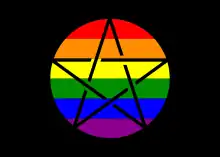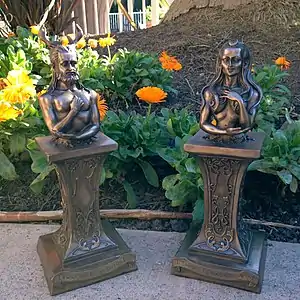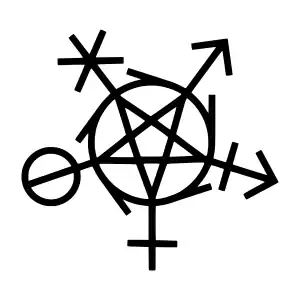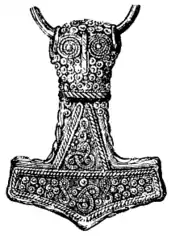Modern Pagan views on LGBT people
Modern Pagan (a.k.a. Neopagan) views on LGBT people, similar to other religious and/or spiritual traditions, vary considerably among different paths, sects, and belief systems.[lower-roman 1] LGBT individuals comprise a much larger percentage of the population in neopagan circles than larger, mainstream religious populations. There are some popular neopagan traditions which have beliefs often in conflict with the LGBT community, and there are also traditions accepting of, created by, or led by LGBT individuals. The majority of conflicts concern heteronormativity and cisnormativity.
| Part of a series on |
| LGBT topics |
|---|
| lesbian ∙ gay ∙ bisexual ∙ transgender |
|
|

Demographics and prevalence
Orientation
A 2003 survey by Helen A. Berger found 28.3% of American neopagans identified in survey as gay, lesbian, or bisexual.[1]
In 2013, a survey of neopagans in England, Wales, Canada, Australia, and New Zealand found 49.8% of women and 44.5% of men identified as non-heterosexual. Of the non-heterosexual female demographic, 78.5% of identified as bisexual and 11.2% identified as lesbian/gay; of the non-heterosexual male demographic, 55.2% identified as gay and 37.1% identified as bisexual.[2]
A 2015 study survey by Pew Research Center found that 11% of lesbian, gay, and bisexual respondents identified with non-Christian faiths, a large portion of which being some form of neopaganism or interfaith universalist beliefs. This was nearly double the general population.[3]
Gender
While the Western neopagan community is gender-diverse as a whole, the demographics tend toward female plurality or dominance in terms of numbers. The aforementioned 2013 scientific survey of Western neopagans found that women were not only the dominant neopagan demographic, but the proportion thereof was increasing across the board in many countries surveyed. However, men tended to dominate certain traditions like Norse Heathenry, Druidry, Neo-Shamanism, Ceremonial Magic, and Thelema.[2][4][5]
Historical gender context
The concept of "the witch" varies significantly among cultures, societies, belief systems, power structures, time periods, and other sociological factors. However, the most predominant Western gender concept of the witch is female stemming from a variety of culture beliefs. This reflects in statistical analysis of historical documents showing that typically those prosecuted for witchcraft were women on average about 70 to 80 percent of the time, most of the time women over the age of 50. Actual practitioners of witchcraft in the general population varied historically. Like today, men were more likely to practice certain disciplines, an example of such being white magic in pre-modern England.[6]
The Malleus Maleficarum (1486), one of the most notable and infamous texts concerning witchcraft, specifically postulated that women were more predisposed or likely to engage in witchcraft and paganism than men, and thus most witches were women.[7] Jean Bodin (a 16th Century French demonologist) is noted to have claimed women are fifty-times more likely to engage in witchcraft.[6][8]
Philosophical and theological issues
The most typical neopagan ideological issues that affect LGBT perception and interaction are sexuality, gender binary dualism, and gender essentialism.[9][10][11][12][13]

Gender dualism, essentialism, and sexual orientation
Binary gender essentialism is highly present in neopagan communities and their respective theological/philosophical belief systems.[11]:390[12]:168 Pagan sources themselves, such as the Pagan Federation of the U.K., align with the academic understanding of pagan essentialism in the gender binary.[14] The basis of the difference is commonly reflected in discussion about spiritual energy, which is often believed to be intrinsically masculine or feminine in type.[11]:391[12]:168[13]:383
A preeminent example of pagan binary belief exists in the common practice of venerating a God-Goddess duality, often specifically the pairing of the Triple Goddess and Horned God.[9]:excerpt[15] The Goddess (representing the feminine) is traditionally seen as receptive, fertile, nurturing, and passive (cast as the Moon), while the God (representing the masculine) as impregnative, a hunter, and active/aggressive (cast as the Sun).[11]:391[12]:167[16][17][lower-roman 2]
This theological archetype is inherently heterosexual and reflected in the beliefs and practices of many neopagan practitioners.[13]:379-80 The gender duality has a significant impact on the working of magic and spellcraft, a widely-held neopagan belief, because tradition requires strict heterosexual pairing to balance and effect the desired magic or spell.[11]:391[12]:170 This can be a struggle for LGBTQ pagans who find the exemplified duality not reflective of their own feelings and desires.[10]:excerpt
Recent historical views on sexuality and gender
In the mid-20th century dawn of Neopaganism, heterosexual dualism was most exemplified in the "Great Rite" of British Traditional Wicca, one of the first notable neopagan ideological groups. In this Rite, a priest and priestess "were cast into rigidly gendered, heteronormative roles" in which the pairing performed a symbolic or literal representation of heterosexual intercourse which was considered vital for venerating supernatural entities and performing magic. It is notable that early neopagan views on sex were radical for their time in their sex positivity and tacit acceptance of BDSM.[11]:391
Later in the 20th Century, as Wicca spread to North America, it incorporated countercultural, second-wave feminist, and LGBTQ elements. The essentialist rigidity fluctuated under the influence of Carl Jung's notions of anima and animus and non-heterosexual orientations became more acceptable.[11]:392[19] By the 1980s and 1990s, figures like Vivianne Crowley and Starhawk continued the evolving beliefs. Crowley associated the Jungian binary with classical elements possessed by all—the feminine/anima with water and the masculine/animus with fire.[19] Starhawk, espousing views similar to Crowley in her 1979 edition of her seminal book The Spiral Dance, began calling into question the masculine-feminine divisions entirely by the 1999 edition, and instead focusing on traits instead of gender archetypes.[11]:392[12]:176-77[20]
At the dawn of the 21st century, queer neopagans and their sects began to assert themselves more publicly. These LGBT-aligned groups "challenged the gender essentialism remaining in the sexual polarity still practiced" which remained in certain Wicca and feminist neopagan enclaves. Greater exploration and acceptance of queer and transgender figures began not only for adherents but deities and mythological figures as well. In addition, sex positivity and BDSM were brought back into active exploration and acceptance.[11]
LGBT issues in specific sects, paths, and traditions

Wicca
Wiccan traditions hold a wide range of differing beliefs about sexual orientation and gender identity. However, Wicca is regarded by many practitioners as a fertility religion. Starhawk wrote in her 1982 book Dreaming the Dark, "Sexuality was a sacrament in the Old Religion; it was (and is) viewed as a powerful force through which the healing, fructifying love of the immanent Goddess was directly known, and could be drawn down to nourish the world, to quicken fertility in human beings and in nature".[21][22]
Most Wiccans worship the Goddess and God.[11]:392[15][23] Melissa Harrington, writing about sexuality and Wicca, noted the Goddess and God themselves, along with the Wheel of the Year that venerates them, are a "predominantly heterosexual model". Harrington also specifies how sexual activity is sacramental to Wiccans.[24] Some asexual Wiccans/pagans have issues with this sexual veneration in regards to their personal beliefs.[25]
Furthermore, a central part of Wiccan liturgy involves the Great Rite;[12][24][26] an act of actual or symbolic ritual sexual intercourse between the two deities. This is traditionally carried out by a priest and priestess who have had the deities invoked upon them, and the conventional practice appears to be exclusively heterosexual. When performed 'in token' this involves the athame (representing the penis) descending into the chalice (representing the vagina).[12][24][27]
Gardnerian and Alexandrian groups typically form their covens from male-female pairs exclusively.[28] Kraemer writes, "The British Traditional Wicca of the 1950s and 1960s saw masculine and feminine energies as wholly distinct from each other, yet complementary. Although masculinity and femininity were to be valued equally, priestesses and priests were cast into rigidly gendered, heteronormative roles."[11]
Gardnerian
Gerald Gardner, the eponymous founder of Gardnerian Wicca, particularly stressed heterosexual approaches to Wicca. As Jan Van Cleve, former practitioner of traditional Wicca, wrote, "Much of Gardnerian magic is based on this notion that physical interaction between male and female is not only desirable, but also necessary."[29] This practice may stem from Gardner's text (ostensibly quoting a witch, but perhaps in his own words):[30]
"The witches tell me 'The law always has been that power must be passed from man to woman or from woman to man, the only exception being when a mother initiates her daughter or a father his son, because they are part of themselves' (the reason is that great love is apt to occur between people who go through the rites together.) They go on to say: 'The Templars broke this age-old rule and passed the power from man to man: this led to sin and in doing so it brought about their downfall.' ... For this reason, they say, the goddess has strictly forbidden a man to be initiated by or to work with a man, or a woman to be initiated by or to work with a woman, the only exceptions being that a father may initiate his son and a mother her daughter, as said above; and the curse of the goddess may be on any who break this law."
— Gerald Gardner, Witchcraft Today (1954)
Gardner was accused of homophobia by Lois Bourne, one of the High Priestesses of the Bricket Wood coven:
"Gerald was homophobic. He had a deep hatred and detestation of homosexuality, which he regarded as a disgusting perversion and a flagrant transgression of natural law... 'There are no homosexual witches, and it is not possible to be a homosexual and a witch' Gerald almost shouted. No one argued with him."[31]
However, the legitimacy of Gardner's rumored homophobia is disputable because Gardner showed much more evidence of an open and accepting attitude about practices in his writing which would not be characterized by the hatred or phobia which was common in the 1950s:
"Also, though the witch ideal is to form perfect couples of people ideally suited to each other, nowadays this is not always possible; the right couples go together and the rest go singly and do as they can. Witchcraft today is largely a case of 'make do'."[32]
As the titular leader of Gardnerian Wicca, it difficult to determine of the above passages whether they represent a personal view of Gardner, Gardner's religious teaching for the sect of Wicca, both, or neither. It is also unclear whether or not these views/teachings changed over time.
Alexandrian
Alex Sanders, the co-founder of Gardnerian offshoot Alexandrian Wicca, came out as bisexual later in life and created new rituals in which sexual orientation was irrelevant. However, a significant portion of Alexandrian belief is regarding heterosexual reproduction, best expressed by his wife and co-founder Maxine Sanders who is well known to emphasize the concept of male-female polarity and the fact that Alexandrian Wicca is a fertility religion. She also expressed concern about a proper functionality of transgender people (referred to as "transvestites") within coven practices, saying it best to look at other traditions that suit them more. "These people", as she is noted to have said, "they're not happy people."[33]

Dianic
Dianic Wicca has become notable for the female-focus and anti-transgender stances of its founder, Zsuzsanna Budapest, and many members. This female-only, radical feminist variant of Wicca allows cisgender lesbians but not transgender women in Dianic covens. This is due to Dianic belief in gender essentialism, specifically "you have to have sometimes [sic] in your life a womb, and ovaries and [menstruate][lower-roman 3] and not die" according to Budapest . This belief and the way it is expressed is often denounced as transphobia and trans-exclusionary radical feminism.[12][34][35][36]
Some Dianic practitioners, such as lesbian priestess Jan Van Cleve, see this discrimination as a reactionary impulse that will someday subside. Van Cleve writes:
"The relationship of the Feminist Movement to Dianic Wicca has been a mixed blessing. On the one hand, it liberated Wiccan women from patriarchal notions of paganism, which claimed that all energy comes from the male/female polarity. The early neo-Pagan leaders were all men and sex between sexes occupied a large part of their attention and sometimes even their rituals. This was rejected by feminists who sought a spirituality they could call exclusively their own. However, as feminism was a reaction to oppression, it carried with it a mindset colored by it. Feminists rebelled against the oppression of men but very soon began to oppress lesbians in their own ranks. The early years of the National Organization of Women, for example, were rife with bitter struggles between straight and lesbian feminists.
Oppression inevitably breeds oppression. The oppressed inevitably become the oppressors. It's the old story of man beats wife, wife yells at child, and child kicks dog. The same thing happened in Dianic Wiccan circles between straight and lesbian Witches. Lesbians, in turn, oppressed Bisexual women, and today some feminists and lesbians are opposed to transgendered women in circle. These are normal growing pains of any movement and as straight and lesbian women have by now largely overcome their orientation differences, they will no doubt soon overcome their fears of their transgendered sisters as well."[37]
Heathenry
Heathenry, neopaganism drawing from historical Scandinavian (Norse) and Germanic pagan beliefs, typically is more ideologically conservative than most neopagan traditions when it comes to gender roles.[11]:395
Norse-Specific
Norse Heathenry has a complex relationship with LGBTQ subjects. The practice of seiðr is typically regarded as women-only magical practice, requiring an openness that draws parallels to the sexually receptive feminine role found in other neopagan beliefs. Non-female practitioners are sometimes targeted with homophobic or effeminate harassment.[11]:395
Racial Paganism
Germanic occultism and neopaganism emerged in the early 20th Century and became influential, with beliefs such as Ariosophy, combining with the far-right Völkisch movement which eventually culminated in Nazism. Post-WWII continuations of similar beliefs have given rise to the Wotansvolk, a white nationalist neopagan movement, in the late 20th Century.[38][39]
Modern white supremacism and Neo-Nazism with all the racist, antisemitic, and anti-LGBTQ beliefs of those ideologies have either continued, infiltrated, and co-opted many Germanic and Norse Heathen traditions such as Ásatrú (sometimes called Odinism). These groups belief that Norse-Germanic beliefs to form the true Caucasian-European ethnoreligious group.[38][39][40]
LGBT-inclusive paths and traditions

Wicca
Newer Wiccan traditions often avoid or disregard the historical aversion to LGBT individuals.[10][11][12][41] Oboler notes the change in neopagan culture thus, "Although the symbolic bedrock of Wicca and modern Paganism is strongly gender-essentialist, the Pagan community, like the culture as a whole, has been moving away from that position."[12] These traditions sometimes cite the Wiccan Charge of the Goddess which says "All acts of Love and Pleasure are My rituals".[22][42] Professor Melissa Harrington wrote that despite traditional Wicca showing heterosexism "as Wicca has grown and attracted gay practitioners they have begun to work out ways in which Wiccan rites can become more meaningful to them".[24]
According to professor and Wicca author Ann-Marie Gallagher, "There is a moralistic doctrine or dogma other than the advice offered in the Wiccan Rede... The only 'law' here is love... It matters that we are gay, straight, bisexual or transgender– the physical world is sacred, and [we are] celebrating our physicality, sexuality, human nature and celebrating the Goddess, Giver of ALL life and soul of ALL nature."[41]
The Pagan Federation of Canada stated, "Over the last few decades, many people have thought that the emphasis on male/female polarity in Wicca excludes homosexuals." However, the Federation goes on to make the case for the validity of LGBT orientations even within traditional Wicca, suggesting that gay men and lesbians are likely to be particularly alive to the interplay of the masculine and feminine principles in the Universe.[43]
Feri
The Feri Tradition, a modern form of traditional witchcraft has provided a home for many neopagan LGBT individuals.[44][45] The Tradition is very open to non-heterosexual orientations and queer identities.[10] Feri practitioner Storm Faerywolf writes:
"As any Queer practitioner can attest, there is a definite shortage of Queer-specific models that encourage the strengthening of ourselves as whole beings. In many Neo-Pagan Witchcraft traditions, we are told simply to adopt the pre-existing (and heterosexist) magickal modalities of polarity and fertility. In the Feri tradition we are given certain tools that enable us to have healthier relationships with our Divine natures, devoid of any such baggage."[46]
Minoan
Two Minoan traditions were founded in New York City in the 1970s. Minoan initiations and elevations are all conducted in single-gender circles. Both traditions continue to this day as oath-bound, initiatory mystery religions using a ritual framework descended from Gardnerian Wicca.[47]
- Minoan Brotherhood founded in 1975 by Edmund Buczynski, an elder in the Gardnerian, WICA, and New York Welsh Traditions, in order to create a tradition for gay and bisexual men—one that would celebrate and explore the distinctive mysteries unique to men who love men.[48][49][47]
- Minoan Sisterhood founded in 1976 by Lady Rhea and Lady Miw-Sekhmet, in collaboration with Buczynski, as the women's counterpart to the Brotherhood.[47]
Phoenix
The Fellowship of the Phoenix (originally "Brotherhood") was founded in the summer of 2004 by seven gay men from diverse traditions such as ceremonial magic, shamanism, and pre-Gardnerian witchcraft in order to create an ecumenical neopagan tradition which serves the community of men who love men. The maxim of the Fellowship is "Find the Divine within your own experience." In 2017, the Seattle Temple began a reformation within the group to expand the tradition to be "open to all queer/LBGTQIA adults" which has been accepted throughout. Fellowship theology has been modified to fit an expanded, inclusive model.[50][51]
Radical Faeries
The Radical Faeries began in the 1970s as a predominantly gay male-oriented movement. The Faeries today are a loosely affiliated worldwide network and countercultural movement seeking to redefine queer consciousness through secular spirituality; the movement also adopts elements from anarchism and environmentalism. Certain events may be focused on gay male spirituality, while others are open to all genders and orientations.[52][53][54][55][56][57]
Naturalist, scientific, and humanist
Scientific pantheists and humanist or atheopagans, as well as others who practice forms of religious naturalism, frequently foster LGBTQ+ inclusion and combat historic bigotries.[58][59][57]
Unitarian Universalism
The Unitarian Universalist Association (UUA) states "we not only open our doors to people of all sexual orientations and gender identities, we value diversity of sexuality and gender and see it as a spiritual gift". The Covenant of Unitarian Universalist Pagans (CUUPS), the pagan-aligned affiliate of the UUA, echoes those beliefs with bylaws that state covenant membership "shall be open, without regard to race, color, sex, affectional or sexual orientation, gender expression, physical disability, national origin, or social condition."[60][61]
See also
Notes
- The minority nature of new religious movements makes it inherently difficult to ascertain perspectives and information, especially for minority viewpoints.
- Janet Farrar described this as an adoption of yin and yang in Western pagan practice.[18]
- Budapest's original wording here is "moon bleed" — terminology common among certain neopagan groups that believe in a link between the lunar cycle and menstrual cycles.
References
- Berger, Helen A., 1949- (2003). Voices from the pagan census : a national survey of witches and neo-pagans in the United States. Leach, Evan A., Shaffer, Leigh S. Columbia, S.C.: University of South Carolina Press. ISBN 1570034885. OCLC 51566739.CS1 maint: multiple names: authors list (link)
- Tøllefsen, Inga Bårdsen; Lewis, James. "Gender and Paganism in Census and Survey Data". The Pomegranate: The International Journal of Pagan Studies.
- "Lesbian, gay and bisexual Americans differ from general public in their religious affiliations". Pew Research Center. 26 May 2015. Archived from the original on 14 February 2020. Retrieved 17 March 2020.
In another contrast, while only 6% of the general public affiliates with a non-Christian faith, almost twice as many (11%) gay, lesbian and bisexual adults do so. And almost half of these gay, lesbian and bisexual adults (or 5% of adults overall) said they belong to one of the smaller faith groups, including Unitarian Universalist and other liberal faith traditions (2.9%) and New Age groups (2.4%), such as Wiccans and pagans. The Jewish and Buddhist faiths also attracted small percentages (2% each) of LGB adults.
- Zell-Ravenheart, Oberon (2004), Grimoire for the Apprentice Wizard, Career Press, p. 24, ISBN 1-56414-711-8
- Murphy-Hiscock, Arin (2006), The Way of the Green Witch, Provenance Press, xii, ISBN 1-59337-500-X
- Rowlands, Alison (1 March 2013). Witchcraft and Gender in Early Modern Europe. Oxford University Press. doi:10.1093/oxfordhb/9780199578160.013.0026.
- Kramer, Heinrich; Sprenger, Jakob (1928) [1486]. The Malleus Maleficarum of Heinrich Kramer and James Sprenger. Translated by Summers, Montague (1971 ed.). Courier Dover Publications. pp. 41–48. ISBN 0-486-22802-9.
- Opitz, Claudia. (2006). Das Universum des Jean Bodin : Staatsbildung, Macht und Geschlecht im 16. Jahrhundert. Frankfurt am/Main: Campus. p. 136. ISBN 978-3-593-38207-4. OCLC 74269994.
- Coles, Donyae (19 June 2017). "Beyond the gender binary in Pagan practice". Spiral Nature Magazine. Archived from the original on 15 April 2019. Retrieved 10 September 2019.
- Faerywolf, Storm (21 October 2000). "The Queer Craft". WitchVox. Archived from the original on 24 January 2020. Retrieved 11 September 2019.
- Kraemer, Christine Hoff. "Gender and Sexuality in Contemporary Paganism". Religion Compass.
- Oboler, Regina Smith (5 June 2011). "Negotiating Gender Essentialism in Contemporary Paganism". Pomegranate: The International Journal of Pagan Studies. 12 (2): 159–184. doi:10.1558/pome.v12i2.159.
- Neitz, Mary Jo (Winter 2000). "Queering the Dragonfest: Changing Sexualities in a Post-Patriarchal Religion". Sociology of Religion. 61 (4): 369–391. doi:10.2307/3712521. JSTOR 3712521.
- "The Pagan Federation - Male Spirit". paganfed.org. Archived from the original on 7 December 2019. Retrieved 10 September 2019.
For a Pagan, the masculine is essentially beautiful, lithe, strong, burning with a deep passion calling out in the joy of creation.
"The Pagan Federation - Female Spirit". paganfed.org. Archived from the original on 23 September 2019. Retrieved 10 September 2019.Priestesses in their own right, strong and proud, with their own vision. ... Women's traditions have an especially powerful vision of the Earth as the Goddess and are deeply involved with caring for the Earth and protecting her from the rape of modern civilization. They are concerned with the healing of the Earth and with the healing of the image of women.
- "What Neopagans Believe". www.neopagan.net. Retrieved 10 September 2019.
Within that overall polytheism, much of Neopaganism is "duotheistic" (with female deities seen as aspects of a single Goddess, and male deities as aspects of a single God).
- "CAWeb - CAW Articles - Who on Earth is the Goddess?". 27 February 2012. Archived from the original on 27 February 2012. Retrieved 11 September 2019.
The eldest and greatest aspect of the Goddess is as Great Mother Nature, the all-encompassing energy of Universal Life. Her womb is the Quasar, the white hole through which all energy pours into creation, and Her all-devouring mouth is the Black hole itself through which all matter is consumed to be reborn once again as between Her thighs the universe is squeezed from spirit. Her energy then coalesces into Matter-Mater-the Mother of all forms. She ignites, becoming the Star Goddess Nuit, whose galactic breast is our Milky way. Of Her are born star systems and planets including, of course, our very own Earth Mother, Gaia. Because of the diversity of the Goddess, She is seen as manifesting in many different aspects. She is often called The Triple Goddess, which refers to Her link in the fertility cycle where She appears as Maiden, Mother and Crone. Some ancient cultures personified this Triplicity as the waxing, full, and waning Moon, and other three-faced Goddess aspects are familiar to us as the Fates, the Graces, the Furies, the Muses, or even as Faith, Hope and Charity. Another familiar division of Her aspects is into Mother and Daughter (Demeter and Persephone), or as Sisters/Lovers (Fauna and Flora). Such polarities are also important in Her worship. Sometimes the polarity can exist with two different aspects of the Goddess representing both poles, but more commonly it is the great gender polarity, for the Goddess is a deity of sexual loving.
- Farrar, Janet; Farrar, Stewart (1989). The Witches' god: Lord of the Dance. London: Robert Hale. ISBN 0-7090-3319-2.
- Farrar, Janet. (1984). The witches' way : principles, rituals and beliefs of modern witchcraft. Farrar, Stewart. London: Hale. p. 166. ISBN 0-7090-1293-4. OCLC 59691718.
Each nature has within itself the seed of the other, like the white spot in the black yin and the black spot in the white yang. In the woman, this is the Animus, her buried masculine component, integration with which enriches her femininity; it tends to manifest especially at the menstrual peak, as her 'other husband' or Moon-partner, who may be either frightening or vitalizing according to her degree of self awareness and the balance she has achieved between her two cyclic sets of values. In man, it is the Anima, his buried feminine component, integration with which correspondingly enriches his masculinity.
- Crowley, Vivianne. (1996). Wicca : the old religion in the new millennium. London: Thorsons. pp. 129–130. ISBN 0-7225-3271-7. OCLC 34190941.
The Goddess and God are manifest to us in dream and vision through what are known as the dominant archetypes. Two major archetypal figures important at this stage of initiation are the archetypes of the opposite sex. Jung called these the Anima and the Animus For a woman, the Animus is the male part of herself. For a man, the Anima is the female part of himself, which traditionally male poets thought of as the Muse. For both sexes, the Animus and Anima are a source of creativity. For a woman, contact with her Animus gives her the creativity that is associated with the Element of Fire. It is the creativity that inspires us to do things, to be active in the world....For a man, his Anima brings the creativity of Water. This is not the creativity of the doer, but the creativity of the artist. It is the creativity that inspires us to compose music, paint pictures, write poems.
- Starhawk. (1979). The spiral dance : a rebirth of the ancient religion of the great goddess (1st ed.). San Francisco. ISBN 0-06-067535-7. OCLC 5334164. Starhawk (1999). The spiral dance : a rebirth of the ancient religion of the great goddess (20th Anniversary, with new introd. and chapter-by- chapter commentary ed.). [San Francisco]: HarperSanFrancisco. ISBN 0-06-250815-6. OCLC 41488828.
- Starhawk. (1982). Dreaming the dark : magic, sex, & politics. Boston: Beacon Press. ISBN 0807010006. OCLC 8281427.
- Xenia (26 November 2014). "God, Goddess, and Other: Fertility faiths and queer identities". Spiral Nature Magazine. Archived from the original on 3 February 2018. Retrieved 11 September 2019.
- Farrar, Janet; Farrar, Stewart (1989). The Witches' God: Lord of the Dance. London: Hale. pp. 170–171. ISBN 0-7090-3319-2. OCLC 59693966.
- Encyclopedia of psychology and religion. Leeming, David Adams, 1937- (2nd ed.). New York. pp. 1638–1641. ISBN 978-1-4614-6086-2. OCLC 865090158. Lay summary – Academia.edu - Harrington, Melissa (2016).CS1 maint: others (link)
- Nox, Celestine (10 July 2017). "Paganism and Asexuality". Archived from the original on 28 February 2020. Retrieved 28 February 2020. Wixom, Sixx (18 July 2014). "Paganism, Asexuality, and the Creative Force". Archived from the original on 28 February 2020. Retrieved 28 February 2020. DuBhran, Kit (11 May 2015). "Asexuality in Paganism". Archived from the original on 28 February 2020. Retrieved 28 February 2020.
- Farrar, Stewart. What Witches Do: A Modern Coven Revealed (1973) London: Sphere Books. pp85-94.
- Crowley, Vivianne. Wicca: The Old Religion in the New Age (1989) London: The Aquarian Press. ISBN 0-85030-737-6 p.234
- "Various Forms of Wicca and Wiccan Traditions". wicca.com. Archived from the original on 27 June 2020. Retrieved 25 June 2020.
- Van Cleve, Janice (27 January 2008). "Gender and Paganism". WitchVox. Archived from the original on 24 January 2020. Retrieved 11 September 2019.
- Gardner, Gerald. Witchcraft Today (1954) London: Rider. p. 69
- Bourne, Lois Dancing with Witches. (2006) London: Robert Hale. ISBN 0-7090-8074-3. p.38. (Hardback edition first published 1998).
- Gardner, Gerald. Witchcraft Today (1954) London: Rider. p. 125
- On the Blackchair Podcast, Special Edition Series #3 - Tea With Maxine - On Initiation
- PANTHEON (1 March 2011). "Transgender Issues in Pagan Religions". PANTHEON. Archived from the original on 25 May 2019. Retrieved 1 May 2018.
- "What is the Dianic Wiccan Tradition?". ThoughtCo. Archived from the original on 15 April 2019. Retrieved 1 May 2018.
- Kaveney, Roz (8 March 2011). "Why won't pagans accept trans women? | Roz Kaveney". The Guardian. ISSN 0261-3077. Archived from the original on 12 February 2020. Retrieved 15 June 2019.
- Van Cleve, Jan (11 February 2008). "Dianic Wicca". WitchVox. Archived from the original on 24 January 2020. Retrieved 11 September 2019.
- Gods and Radicals (6 April 2016). "Rainbow Heathenry: Is a Left-Wing, Multicultural Asatru Possible?". GODS & RADICALS. Archived from the original on 17 January 2020. Retrieved 11 December 2019.
- "New Brand of Racist Odinist Religion on the March". Southern Poverty Law Center. Archived from the original on 14 January 2020. Retrieved 11 December 2019.
- Samuel, Sigal (2 November 2017). "What To Do When Racists Try To Hijack Your Religion". The Atlantic. Archived from the original on 9 March 2019. Retrieved 11 December 2019.
- Gallagher, Ann-Marie (2005). The Wicca Bible: the Definitive Guide to Magic and the Craft. New York: Sterling Publishing. ISBN 978-1-4027-3008-5. OCLC 61680143.
- Gardner, Gerald. Witchcraft and the Book of Shadows (2004) Edited by A.R.Naylor. Thame, Oxfordshire: I-H-O Books, p.70. ISBN 1-872189-52-0
- Huneault, Robert.Homosexuality and Wicca. Pagan Federation/Fédération Païenne Canada website, accessed 11 May 2007. Archived 29 December 2007 at the Wayback Machine
- August 2019, Holly Mosley1 | 7. "Witching Hour: How LGBTQ+ views differ within Wicca and Paganism". www.femalefirst.co.uk. Retrieved 11 September 2019.
- "Feri Tradition Resources: articles and information related to Faery Tradition, Faerie Tradition, Fairy Tradition witchcraft". www.feritradition.com. Archived from the original on 9 May 2017. Retrieved 11 September 2019.
- Faerywolf, Storm (8 May 2005). "The Amethyst Pentacle". WitchVox. Archived from the original on 24 January 2020. Retrieved 11 September 2019.
- "The Minoan Brotherhood". www.minoan-brotherhood.org. Archived from the original on 17 July 2019. Retrieved 11 September 2019.
- Adler, Margot (2006). Drawing down the moon : witches, Druids, goddess-worshippers, and other pagans in America ([Revised and updated] ed.). New York: Penguin Books. ISBN 9780143038191. OCLC 65341257.
- Aburrow, Yvonne (21 June 2007). "Wicca". glbtq.com. Archived from the original on 11 October 2007. Retrieved 16 August 2007.
- "Our Core Philosophies – Fellowship of the Phoenix". Retrieved 11 September 2019.
- "Our Organization – Fellowship of the Phoenix". Archived from the original on 8 December 2019. Retrieved 11 September 2019.
- Carroll, Rory; Holpuch, Amanda (28 June 2015). "Hold the applause for Facebook's rainbow-colored profiles, activists say". The Guardian. London. Archived from the original on 29 June 2015. Retrieved 28 June 2015.
- "About – radfae". Archived from the original on 1 August 2019. Retrieved 11 September 2019.
- "FAQ's". austinradfae.org. Archived from the original on 3 September 2018. Retrieved 11 September 2019.
- Introduction to new and alternative religions in America. Gallagher, Eugene V., Ashcraft, W. Michael, 1955-. Westport, Conn.: Greenwood Press. 2006. pp. 260. ISBN 9780313050787. OCLC 230763437.CS1 maint: others (link)
- Morgensen, Scott. 2009. "Back and Forth to the Land: Negotiating Rural and Urban Sexuality Among the Radical Faeries." In Ellen Lewin and William L. Leap eds. Out in Public: Reinventing Lesbian / Gay Anthropology in a Globalizing World: Readings in Engaged Anthropology. John Wiley and Sons. ISBN 1-4051-9101-5, ISBN 978-1-4051-9101-2.
- Sable Aradia (5 July 2015). "Transphobia is Anti-Feminist". Humanistic Paganism. Archived from the original on 9 December 2019. Retrieved 9 December 2019.
- Mark Green (9 November 2018). "Inclusiveness Starts with Your Ideas". Atheopaganism: an Earth-honoring religious path rooted in science. Archived from the original on 9 December 2019. Retrieved 9 December 2019.
- Lupa Greenwolf & Jon Cleland Host (31 August 2016). "Honoring our Ancestors: Racism Rears its head". Humanistic Paganism. Archived from the original on 9 December 2019. Retrieved 9 December 2019.
- "LGBTQ Justice". Unitarian Universalist Association. 8 August 2014. Archived from the original on 1 February 2020. Retrieved 10 December 2019.
- "Covenant of Unitarian Universalist Pagans - CUUPS Bylaws". Covenant of Unitarian Universalist Pagans. Archived from the original on 10 December 2019. Retrieved 10 December 2019.
Further reading
- Barrett, Ruth (2003), "Lesbian Rituals and Dianic Tradition" in Ramona Faith Oswald (ed), Lesbian Rites: Symbolic Acts and the Power of Community, The Haworth Press.
- Conner, Randy P. (1993), Blossom of Bone: Reclaiming the Connections between Homoeroticism and the Sacred, San Francisco: Harper.
- Conner, Randy P., Sparks, David Hatfield, and Sparks, Mariya (1997), Cassell's Encyclopedia of Queer Myth, Symbol and Spirit, London and New York: Cassell.
- Evans, Arthur (1978), Witchcraft and the Gay Counterculture: A Radical View of Western Civilization and Some of the People It Has Tried to Destroy, Boston: Fag Rag Books.
- Ford, Thomas Michael (2005), The Path of the Green Man: Gay Men, Wicca and Living a Magical Life, New York: Citadel Press.
- Omphalos, C., Polanshek, J., Pond, G., Tanner, P., Thompson, S., eds. (2012), Gender and Transgender in Modern Paganism, Cupertino: Circle of Cerridwen Press. With contributions by Ruth Barrett, Gavin Bone, Janet Farrar, and Raven Kaldera.

